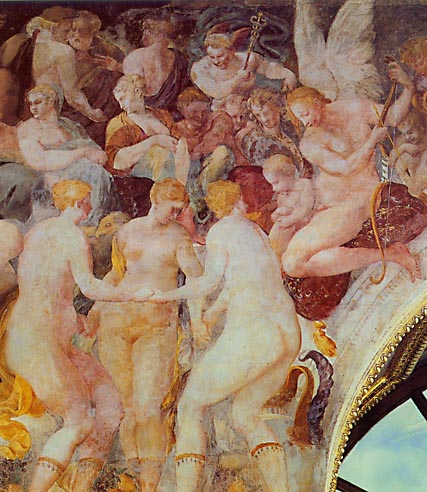 |
|
La reine Catherine de Médicis
fait placer dans la basse-cour
un moulage en plâtre du cheval antique de l'Empereur romain Marc-Aurèle,
elle devient la "Cour du
Cheval Blanc".
Philibert Delorme achève la chapelle de la trinité.
Sous le règne de Charles IX on donne de nombreuses réceptions à
Fontainebleau dont la plus célèbre est celle offerte par le roi et sa mère,
Catherine de Médicis, aux ambassadeurs du Pape et de l'Empereur d'Espagne, Philippe II.
Cent cinquante filles d'honneurs assistent avec les princes et les plénipotentiaires à la "Bergerie"
de Ronsard. Durant cette fête on prépare un tour de France pour le roi de
quatorze ans qu'on veut semblable à celui de son grand père François 1er.
(En 1564 débute la construction du palais des Tuileries à
Paris sous la direction de Philibert Delorme et de Jean Bullan).
|
The queen, Catherine de Medici,
had installed in the lower courtyard
a plaster cast of an antique equestrian statue of the Roman Emperor Marcus Aurelius.
The courtyard became the “White Horse Courtyard”.
Philibert Delorme completed the Trinity Chapel.
During Charles IX’s reign many receptions were given at Fontainebleau.
The most celebrated was given by the king and his mother, Catherine de Medici,
for the ambassadors of the Pope and the Spanish Emperor Philip II.
Five hundred maids of honour attended
with the princes and plenipotentiaries at Ronsard’s “Bergerie”.
During the festivity a tour of France was prepared for the 14-year-old king,
intended to be like a repeat of the one his grandfather François I had taken.
(In 1564 building started on the Tuileries Palace in Paris directed by
Philibert Delorme and Jean Bullan).
|
 |
|
She was Henri II´s wife, and mother of François II,
Charles IX and Henri III. She took on the regency during Charles IX reign until he reached the age of majority.
Catherine de Medici was a clever politician and unscrupulous, but had no overall view.
She tried to rule by dividing various camps and did not succeed in preventing wars of religion.
She played the major role in the St Bartholomew´s massacre of protestants.
 Catherine de Médicis 1519-1589 Femme de Henri II, mère de François II, Charles IX et Henri III,
elle fut régente du royaume pendant la minorité de Charles IX.
Politique habile, sans scrupule, sans hauteur de vues, essayant de règner par la division des camps,
elle ne sut empêcher le développement des guerres de religion.
Elle eut la plus grande part au massacre des protestants -dit de la St. Barthélemy-
|
 The Trinity Chapelle La chapelle de la Trinité |
|
This king´s reign is one of the worst that France ever experienced.
Religious strife, wars and massacres wreaked havoc throughout the land.
However, certain measures were achieved, like the foundation of the French guards (1563),
the proclamation of the state of inalienability of the crown estate (Moulins 1566),
the fixing of the New Year at January 1st as opposed to the eve of Easter which was the case up to then (1564).

Charles IX 1560-1574 Le règne de ce roi est un des pires que la France ait subis.
Les guerres et les massacres religieux ravagent le pays.
On notera cependant, la création du corps des gardes Françaises (1563),
la proclamation de l'inaliénabilité du domaine royal ( Moulins-1566-), la fixation du début de l'année au 1er Janvier,
auparavant l'année commençait la veille de Pâques. (1564)
|

The three Graces dancing before the Gods. Les trois Grâces dansant devant les Dieux. |